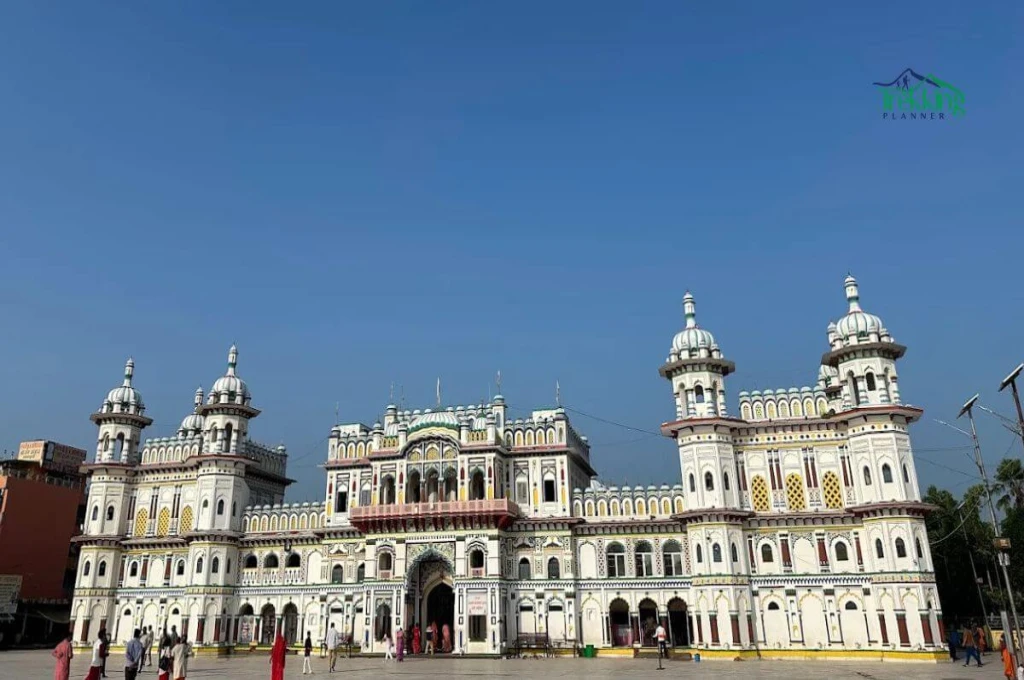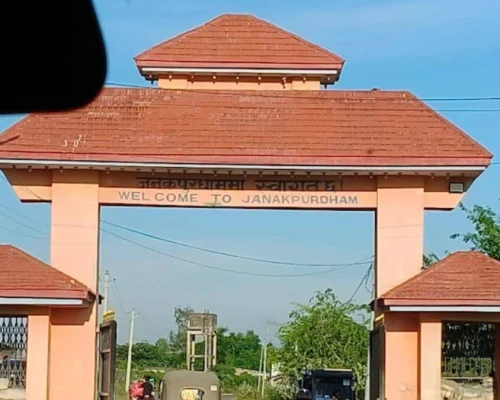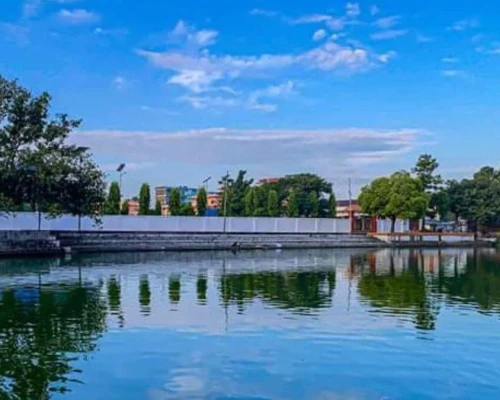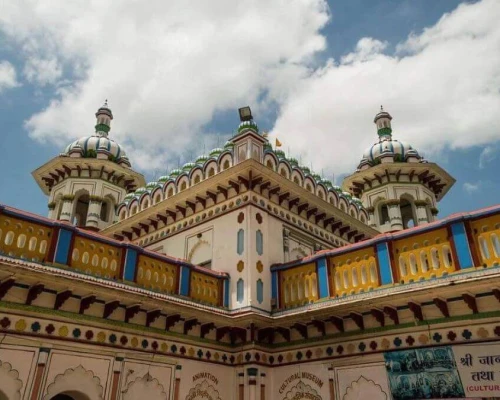Introduction: Janakpur and Janaki Mandir
Janakpur is Nepal's most important cultural and religious city, situated in the fertile plains of the Terai, some 225 km southeast of Kathmandu. It is the birthplace of Goddess Sita and the site of her wedding to Lord Ram, and hence an area deeply identified with the epic Ramayana.
But Janakpur is not just a pilgrimage hub. It's the cultural hub of Mithila, renowned for its traditions, languages, festivals, music, and the world-famous Mithila paintings. Pilgrims, spiritual travelers, and culture enthusiasts from Nepal, India, and abroad flock here all year round, mainly during Vivah Panchami (the sacred wedding of Sita and Ram) and Ram Navami (Lord Ram's birthday anniversary).
A day trip from Kathmandu to Janakpur City is the perfect way to discover Nepal's southern culture, hospitality, and understanding of Hindu mythological living traditions.
Travelers can visit Janakpur all year round. However, the best time to visit Janakpur city is during the Spring and Autumn. Spring, lasting from March to May, and Autumn, lasting from September to November, provide the best weather conditions for comfortable exploration. It is also recommended to plan the Janakpur city tour between November and December. The time falls under the festival of Vivaha Panchami, which is celebrated to commemorate the wedding celebration of Lord Ram and Sita.
So, join Trekking Planner Nepalfor a day filled with adventure in Janakpur. Let's explore the beautiful Hindu temple, ponds, and the magical Janaki Temple.
History of Janakpur and Janaki Temple
Anciently, Janakpur was the capital of the Mithila Kingdom, which King Janak ruled. King Janak was considered a philosopher king, renowned for his justice and wisdom.
His daughter, Princess Sita, is revered in Hinduism as an avatar of the Goddess Lakshmi and is the heroine of the legendary epic, the Ramayana.
According to the epic, Lord Rama of Ayodhya broke the sacred bow of Lord Shiva during a swayamvar (competition) held in the palace of King Janak and married Sita. It was this holy activity that was reenacted at Janakpur. Therefore, the city is the most sacred Hindu pilgrimage center in the world.
The Janaki Mandir, built in 1910 by Queen Brisabhanu Kunwari of Tikamgarh (India), is a work of art. Built using white marble and colored tiles, the temple embodies a blend of Rajput and Mughal architectural styles. Within the temple, a sacred statue of Goddess Sita lies, which is claimed to have been discovered in the Saryu River.
The temple is also known as the Nau Lakha Mandir, as it is said that nine lakhs (900,000) rupees were needed to build it. Janakpur is not only a religious hub today, but also a living museum of Mithila culture, where daily life is richly depicted through festivals, rituals, paintings, and various forms of art.
How Does the Janakpur City Tour Begin and End?
Your Janakpur City Tour begins early in the morning from Kathmandu, when our Trekking Planner Nepal representative welcomes you at your hotel and accompanies you to Tribhuvan International Airport. A short and breathtaking 35-minute domestic flight transports you straight to Janakpur Airport, within a few kilometers of the heart of the city.
Upon your arrival, your local cultural guide will greet you and accompany you throughout the day. The tour officially begins at the lovely Janaki Mandir, followed by other temples, ponds, and cultural sites. At lunchtime, we'll have a traditional Maithili meal at a local eatery.
In the afternoon, you'll continue exploring Janakpur's bustling bazaars, Mithila art centers, and—if time allows—make a short excursion to Dhanush Adham. The tour ends in the evening with a return flight back to Kathmandu, followed by a transfer to your hotel.
Alternative Option:
Travelers who do not mind driving can charter a private car from Kathmandu to Janakpur (7–8 hours round trip). But since the day is long, flying is highly recommended for a one-day leisurely tour.
Reserve your Janakpur Tour Package now and walk through sacred temples, vibrant markets, and timeless Ramayana legends. Contact us now!
Who Can Take the Janakpur City Tour?
The Janakpur City Tour is suited for a wide range of tourists:
- Pilgrims & Devotees: Hindus who wish to visit Janaki Mandir, Vivah Mandap, and sacred lakes.
- Cultural Enthusiasts: Tourists seeking to experience Mithila's rich culture, vibrant festivals, and diverse art forms.
- History & Mythology Lovers: People who are interested in the Ramayana stories and the heritage of King Janak.
- General Travelers: Anyone who has a spare day in Kathmandu who wishes to see another side of Nepal other than the mountains.
- Photographers & Artists: Janakpur's dynamic temples, busy markets, and Mithila paintings offer endless sources of inspiration.
What is the Best Time to Visit Janakpur?
As mentioned, visitors can travel to Janakpur all year round. But the best time to visit is during the Spring and Autumn seasons. These seasons provide the perfect combination of weather, accessibility, and culture, thereby providing an unforgettable experience.
Autumn (September to November): The Autumn season is among the best times to visit Janakpur. The season offers clear skies and cool temperatures, which provide an ideal time for sightseeing and city tours. The average temperature during Autumn is 20–28°C, so there are significantly fewer climatic extremes during the autumn months. Thus, Autumn is regarded as the best time to visit Nepaland go on the One-day Janakpur City Tour. Likewise, grand festivals like Vivah Panchami and Chhath Puja fall during the Autumn. The inclusion of these celebrations during the exploration of the vibrant city makes for colorful processions, music, and rituals.
Winter (January to February): Winter is not a very favorable time for a Janakpur city tour. The cold weather conditions may hamper the experience. The average warm temperature ranges from 10 to 20°C, so visitors need to prepare for these conditions. But the advantage of visiting during winter is the fewer crowds. Due to the cold, fewer travelers are found in the city. With fewer tourists, people can gain valuable insights and experience in-depth cultural immersion. It is also easier to understand more about the culture, tradition, and lifestyle around the city. This location makes it a perfect destination for tourists who prefer quiet sightseeing.
Spring (March to April): Spring in Nepal is another of the best seasons for the Janakpur city tour. Springtime provides a pleasant atmosphere with clear skies and moderate temperatures. The average temperature during spring days is 20–28°C, which offers comfortable walking conditions. The spring season is also marked by blooming flowers and cultural festivals that add vibrant experiences to the tour. Ram Navami celebrations, which fall during spring, are also a real festival treat.
Summer (May to August): It is generally considered an off-season for tours and travel. As Janakpur lies in the terai region of Nepal, which is hot primarily throughout the year. However, during the summer, the temperature rises significantly, making it more challenging to perform daily activities. The average daily temperature during summer is 28–35°C. The summer season is also wet due to unseasonal monsoon rains, making temple visits less comfortable. But there are fewer tourists in these months, allowing travelers to roam peacefully around the temple areas.
Practical Tips for Visitors During Janakpur Tour
- Dress Humble: While in temples, cover the knees and shoulders. Lightweight and loose clothing is appropriate in summer; layers are more suitable for winter.
- Temple Etiquette: Always remove your footwear and headgear when entering temples. Speak softly and refrain from interrupting rituals.
- Photography: Temples and religious rituals can be photographed, but always obtain permission, especially if locals or priests are present.
- Hydration & food: Pack bottled water and avoid raw street food if your stomach is sensitive. Lunch at a local restaurant is safe and real.
- Cash & shopping: Markets in Janakpur do not accept cards. Set aside some small amount of money for donations, shopping, or transportation.
- Interaction with locals: Locals in Janakpur are warm. Some Maithili or Nepali phrases, such as Namaste or Dhanyabad, enhance interactions.
- Footwear: Comfortable walking shoes. Temple complexes and bazaars have rough pavements.
- Timing: Start the day early to avoid crowds at Janaki Mandir and have a relaxed schedule.
- Health: If sun- or heat-sensitive, carry sunscreen, sunglasses, and a hat.






